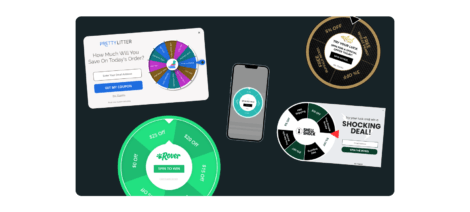E-commerce is a booming industry, and with increasing competition comes increased costs of advertising. This is why learning how to optimize your average order value (AOV) is critical to a healthy return on ad spend (ROAS), and even more so during the holiday season.
With the most expensive season for ad spend already upon us, it’s critical to ensure that you’re making the most out of your budget. This is also a great time to learn a few best practices that can be implemented throughout the year. We’ll cover the basics of both AOV and ROAS, share some holiday-specific tips for optimizing the ratio between the two, and propose strategies to handle this balancing act that will enhance your bottom line throughout the year.
AOV vs. Ad Spend: What Is the Difference
AOV and ad spend are two different metrics used in marketing and e-commerce to evaluate performance and measure the effectiveness of a marketing campaign. Here is the difference between AOV vs. Ad Spend.
- AOV (Average Order Value): AOV refers to the average amount of money a customer spends per order when making a purchase. It is determined by dividing the total revenue generated from orders by the total number of orders during a specific time period. A higher AOV shows that customers are spending more per order, which is good for businesses as it raises revenue without necessarily necessitating a rise in the number of purchases.
- Ad Spend: Ad spend, also known as advertising expenditure or advertising spend, refers to the amount of money a company invests in advertising and marketing efforts to promote its products or services. It includes the cost of various advertising channels such as online ads, TV commercials, print media, and more. Ad spend is typically measured within a specific time frame, such as a month or a year, and is used to determine the financial resources allocated to advertising campaigns.
To sum it up, AOV measures the typical amount spent by customers on a single order, whereas ad spend is the sum of money spent by a company on advertising and marketing initiatives. These key metrics offer valuable insights for decision-making and the optimization of marketing efforts, and are used to assess many elements of corporate performance and advertising success.
Optimizing ad spend
Paid advertising is a great way to acquire new customers and drive traffic to your site, but it can also be costly, and if not done effectively, it won’t have any viable return on investment. Your return on ad spend (ROAS) is something that you should keep an eye on as a general barometer for the effectiveness of a paid ad marketing strategy.
The formula for ROAS:
ROAS = Campaign Revenue/ Ad Spend
Let’s say you spend $100 on paid advertising and subsequently convert those clicks into $500 in revenue. In this case, your ROAS would be 5:1. Obviously this isn’t your actual profit margin since you haven’t taken into account overall expenses, but as a general metric, it can provide a good idea of how much business you’re driving from paid traffic initiatives. This straightforward ratio allows you to easily scale up your efforts with additional advertising spend, and potentially forecast expected revenue gains from any increased spends.
If you want to optimize your ROAS, targeting expensive paid-traffic-segments with lucrative offers can lead directly to more conversions, increased ROAS, and increased lifetime value for these customers. Those who have bought from you previously will need less convincing to purchase again, more than likely offsetting the increased initial CPA.
An additional bonus is that many advertising platforms are increasingly promoting conversion results over clicks, CPM, and other traditional paid traffic metrics. By increasing your conversion rates coming from your ads, you have the effect of increasing the perceived ‘quality’ of these ads and your landing pages, subsequently opening opportunities for lower costs and increased percentages of optimal ad placement.
Optimizing average order value
Average order value (AOV) is exactly what it sounds like–how much on average each order is worth to your business:
AOV = Revenue/ Number of Orders
This is easily one of the most important metrics you track as a business and is an important indicator as to the health and profitability of your business.
AOV can also show you the most important season for your site to focus on (and it may not be the one you expect). Start by looking at the messaging and time of year that is most engaging for your highest value customers. While this isn’t the only segment you should focus on, it’s one that should provide some of the quickest results.
Knowing the timing and message content that’s most valuable to your site is another important step to optimizing your AOV. Here’s a few strategies for how to increase your AOV and how they work:
Bundling
Sell two products together, ideally one product is a best seller and the other is one whose numbers are lagging behind. This way you’re clearing the slower moving inventory off your shelves while also increasing the average order value.
With end of year sales coming to a close soon, consider using bundle offers to help unload any excess inventory you’re trying to rid yourself of for the new year.
Upsell/cross-sell
These are the go-to tactics for increasing average order value, and is probably the ones you’re most familiar with. Upselling encourages shoppers to spring for the more expensive version of a product they’ve selected, while cross-selling is selling a product to use in tandem with another one. Check out our Commerce AI section where you can create intelligent product recommendation promotions that can automatically execute both of these tactics to drive your AOV growth.
Pro-Tip: An easy way to remember the difference is with these widely-known examples:
Upsell = “Would you like to supersize that?”
Cross-sell = “Would you like fries with that?”
Repeat buyer encouragement
Offer a discount on their second purchase soon after they received their first order. This encourages them to come back to your site, purchase again, purchase in larger amounts, and ideally turn them into a consistent, loyal customer.
Free shipping thresholds
Shipping costs are one of the top reasons for abandoned carts when online shopping. Figure out what your current AOV is, and then set your free shipping threshold above than that number. This provides an incentive for customers to spend a little more money to unlock the threshold, and boosts your order values in no time.
Already offer free shipping or don’t think free shipping fits your brand? Some other options to consider are to offer free upgrades to accelerated shipping speeds, or complimentary gift wrapping.
Partner insights
These are all great tactics to implement both during the holidays and throughout the year depending on what you discover appeals most to your customer segments, but keep in mind what Daniel Chen, Head of Media Buying from our agency partner, Hawke Media, has to say:
With all the multiple ways to increase AOV, it is best to test them one at a time, to truly gauge what will be successful. The first step to that is understanding who your customer is, how your brand and your product appeals to them and seasonality. Certain strategies will only work on certain types of customers and only during certain times of the year.

Head of Media Buying, Hawke Media
The holiday mindset
During the holidays it’s completely understandable to spend more on paid advertising. Competition is fierce during this time of year, so paying for premium placement is understandably going to cost more.
There’s nothing wrong with this, but it’s important to note that during the holidays you’re also in a race to the bottom in terms of price with your competitors (for the most part).
Partner insights
Courtney O’Donnell, the Director of Shopping & Feed at our agency partner, Tinuiti, had this to say about how to handle the complex AOV/Ad Spend ratio during the holidays:
AOV is an important metric for brands; the higher the AOV, the more you get out of every customer. This allows overall ad dollars to go further. But during the holidays two things happen: brands offer their products at discounted rates and at the same time increase ad spend to ensure competitive ad placements. This makes it harder to achieve the perfect AOV to ad spend ratio. As you move into the holiday season ad spend should be a more important metric than AOV as you want to continue a strong brand presence and bring users to your site to purchase versus going to the competition.

Director of Shopping & Feed, Tinuiti
Our friends over at Tinuiti have the right idea. During the holidays, your focus on metrics and definition of what “success” looks like will change as a reflection of the seasonal makeup of your site visitors.
There are also additional ways to make the most of your holiday marketing budget. Our agency partner, Hawke Media, recommends consolidating Facebook audiences to more efficiently optimize the Facebook algorithms to find your ideal audience:
Another way to make the most of your holiday budget [is] consolidating your interest based audiences. By putting them together in a single adset (even if they are different affinities) you’re able to reach FB’s best practice recommendation of 50 conversions per week – allowing for facebook to learn faster, more efficiently, and acquire the audience at a cheaper rate. This realized on one of our larger spend accounts and confirmed by Facebook reps.

Paid Media Supervisor, Hawke Media
Understanding how to pivot your strategy for the holidays, appeal to more valuable customers, and also get the most bang for your ad buck is key to coming out on top at the end of Q4.
Year-long balancing act
Increased AOV means that as a business you can afford a higher ROAS ratio and if you are a business with lower traffic numbers, paid advertising can be a much needed traffic source for you. With a focus on boosting AOV, you can unite acquisition efforts with on-site optimization, creating the ultimate duo working in tandem for acquiring new shoppers and encouraging them to spend more.
There’s one other metric to discuss when you are considering how to gauge the health of your marketing strategy: Customer Lifetime Value (CLV). CLV is the overall worth of a customer over the course of their entire relationship with your brand that also takes into account the cost of acquiring them. Balancing AOV, ROAS, and CLV with an overarching retention strategy will promote consistent success for your brand.
Final thoughts
The ratio between AOV and ad spend is a perfect gauge of the profitability of your acquisition and retention programs. These numbers all work in tandem, some being more telling than others, not only about the health of your bottom line, but also your overall marketing effectiveness. As the year ebbs and flows you’ll have some periods more focused on acquisition (higher Ad Spend) and some more focused on retention (higher AOV and CLV).
With the holiday season coming to an end soon, it’s important to note that your metrics will start to even out. Compare current performance to last year’s to uncover hidden trends, new opportunities, or places where you’ve been wasting money. There’s never a bad time to start optimizing and making the most of your marketing budget!



